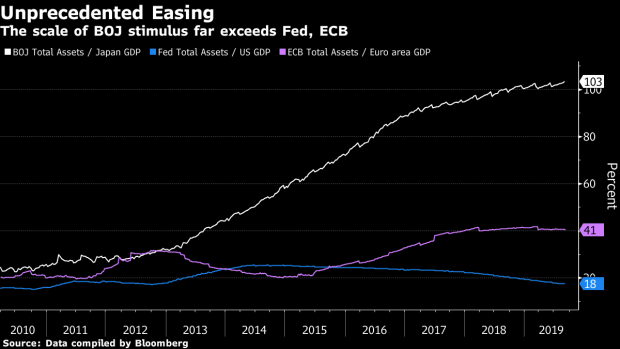Sep 18, 2019
BOJ Leaves Policy Unchanged, Calls for Review After Fed Cuts
, Bloomberg News

(Bloomberg) -- The Bank of Japan left its monetary stimulus unchanged and called for a rexamination of prices and the economy at its October meeting, choosing to sit tight for now just hours after the Federal Reserve cut interest rates again.
The BOJ kept its interest rates and asset purchases at existing levels, it said in a statement Thursday, a result forecast by about three quarters of economists surveyed by Bloomberg.
The BOJ will review the economy and inflation at the next gathering starting Oct. 30, it said. A previous comprehensive assessment in 2016 led to the creation of the current policy framework, yield curve control. The central bank said Thursday that it needed to pay closer attention to the risk of losing momentum toward its 2% inflation target.
The call for a review comes as global central banks move to support economic growth and head off rising risks. Those moves raised expectations that the BOJ might follow suit, partly to prevent a stronger yen from hampering its efforts to stoke inflation. The European Central Bank last week cut rates and revived bond purchases.
Yet many BOJ watchers also see the central bank’s firepower as depleted, while side effects from its stimulus program are piling up. So a reversal in the yen in recent weeks likely helped give Governor Haruhiko Kuroda room to hold off acting for at least a while longer.
“The basic strategy for the BOJ is to be patient and keep its current stimulus going,” Yasunari Ueno, chief market economist at Mizuho Securities Co., said before the decision was announced.
Kuroda said in July that the central bank had become “more positive” about increasing stimulus, but Thursday’s decision demonstrates ample patience from a central bank chief who has long stressed his willingness to take preemptive action.
Still, the BOJ reiterated in its statement that it won’t hesitate to add stimulus if risks to momentum toward its 2% inflation target become heightened.
The yen was trading around 108 yen on Thursday morning after touching 104.46 last month, the strongest level since November 2016. Economists generally see a move to 100 as a trigger for the central bank to cut its negative rate.
What Bloomberg’s Economists Say
“Pressure to take some form of action is strong, with plunging global yields and other major central banks boosting stimulus.”
Yuki Masujima, economist
Click here to read more
Another headache for the BOJ’s policy operation has eased for now. Japan’s 10-year government bond yield is trading within BOJ’s target range after touching a three-year low of -0.295%, a level some BOJ officials said was close to requiring action, according to people familiar with the matter.
Still, fundamental challenges remain. Inflation stood at 0.6% in July, far from the BOJ’s 2% target. Exports have declined every month this year. And a sales tax hike taking effect next month is expected to hit domestic demand, which has helped sustain growth during the export slump.
In fact, an increasing number of economists -- 83% in the latest Bloomberg survey -- say the next policy step will be additional stimulus.
Kuroda holds a press conference starting at 3:30 p.m.
--With assistance from Yoshiaki Nohara, Emi Urabe, Russell Ward, Keiko Ujikane, Junko Yoshihara, Go Onomitsu, Sophie Jackman and Brett Miller.
To contact the reporters on this story: Toru Fujioka in Tokyo at tfujioka1@bloomberg.net;Sumio Ito in Tokyo at sito58@bloomberg.net
To contact the editors responsible for this story: Malcolm Scott at mscott23@bloomberg.net, Henry Hoenig, Paul Jackson
©2019 Bloomberg L.P.